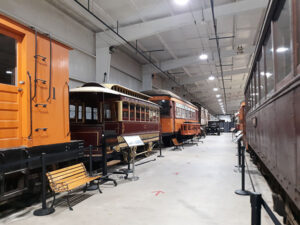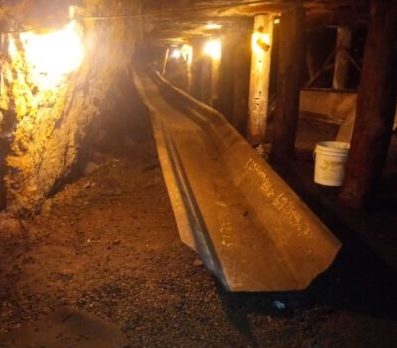Trains . . . planes . . . automobiles. If your children are like mine, they have an innate fascination with transportation systems, a fascination that has prompted our latest adventure to learn about some of the ways that people get around. It turns out Pennsylvania is full of such attractions, so it seems there are plenty of families just like mine.
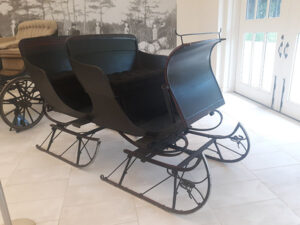
Sleighs like this four-passenger bobsled at the Frick Car and Carriage Museum were difficult to stop quickly and so the sound of jingle bells on the horses alerted others to its approach.
Our first journey is to the Car and Carriage Museum, a free museum that is part of The Frick Pittsburgh.[1] We discuss our vehicles on paved roads and compared them to other modes of travel—for example, how it would take longer to stop a sleigh gliding over smooth snow than a carriage rolling along on a bumpy dirt road. We learn that sleighs traveled so quietly that bells had to be added to the horses’ harnesses to warn pedestrians walking nearby, and we then compare this to modern hybrid cars. Although my boys gravitate toward the early automobiles, I linger at the exhibits of sleighs and carriages. The sleigh conjures up delightful images of Count Rostov’s family traveling under warm fur blankets in War and Peace and Helen Clay Frick’s pony phaeton bringing Miss de Bourgh’s on daily outings in Pride and Prejudice.
In addition to their standing display of sleighs, carriages, and early automobiles, the Car and Carriage Museum has a special exhibit of accessories developed to stylize early cars. We learn that early internal combustion engines had limited use because they would overheat; therefore, early automobiles were often electric or steam-powered vehicles. Until the improvement of coolant pumps made gas-powered vehicles popular, a motometer measured engine temperature. Hood ornaments (typically integrated with the motometer) showed off the prestige of the owner and manufacturer; glass and lucite hood ornaments both provided style and illumination, and the boys light one up using a hand crank. We remark about the prices of the cars and the diversity of manufacturers and accessories; we discuss how Henry Ford’s assembly line helped to lower the price of cars but also put many of these small manufacturers out of business.
We also learn more about the infrastructure and social changes resulting from the automobile’s autonomy—the development of the suburb, vacation travel, and the decline of public transit systems—bringing us to our next adventure near Washington, PA.[2] The Pennsylvania Trolley Museum is the final resting place of many trolleys—those which were spared the literal inferno that consumed countless others around the country. Interests piqued, we explore both the physical museum and its virtual offerings.
Admission to the museum provides unlimited trolley rides, a tour of dozens of trolleys (including the one with which Mr. Rogers was photographed), exhibits, and the trolley simulator. My children love the trolley simulator so much and are so engrossed that we have to remind them to give turns to other visitors standing nearby. For those with a valid driver’s license, you can drive an actual trolley (the “Operator for an Hour” experience), so I suspect we’ll be back in the future. The museum is staffed almost entirely by volunteers, and it is wonderful to bask in their passion.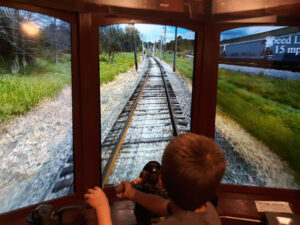
The virtual offerings of the Pennsylvania Trolley Museum include an interesting series of YouTube videos called Trolleyology. After our visit, we watch one called “Car Line Adventures – Trolley Tales from the Sublime to the Ridiculous”; my son is fascinated by the diversity of anecdotes. He regales his father at dinner with such stories as how someone lost their grandmother on the trolley, how a thief handcuffed a passenger as part of a “magic trick” (the poor gentleman was stuck for six hours while various police stations searched for the right key), and the number of times trolleys were stolen! I would highly recommend this virtual offering for its fascinating true stories from history.
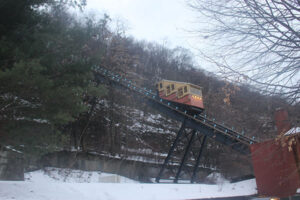
Two incline cars operate simultaneously to move passengers between the Station Square and Grandview Avenue Stations.
At the end of our visit, our boys compare trolleys to cars and discuss why they think the popularity of trolleys waned as more families could afford cars. Although less popular, trolleys have not gone away in Pennsylvania, so we aspire to ride on Pittsburgh’s Port Authority system. We park on Mt. Washington near Grandview Avenue Station, where we learn that German immigrants living on the mountain eventually grew weary of climbing the steep footpaths and steps to go home after work each day—a commute we can’t begin to imagine—and, recollecting their homelands, promoted the construction of the inclines we see today. The Monongahela Inclined Plane, one of the steepest in the nation,[3] brings us from the mountain heights to the river valley’s trolley line.
Passes in hand, we board the incline car and take in the view of the city as we descend to Station Square, a popular shopping and dining area with trolley and bus connections. Our pass gives us unlimited rides throughout the public transportation system, and we gladly avail ourselves of it.
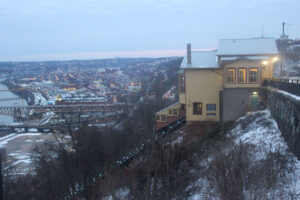
The incline cars can be seen leaving and entering the Grandview Avenue Station from one of Mt. Washington’s scenic overlooks.
For my children, this is an exciting experience, and they love the opportunity to travel “untethered” by trolley and bus. Novelty aside, a field trip on public transit also provides valuable real-world preparation for college, tourism, and employment. Knowing how to purchase our fare, identifying what route(s) to take for our desired destination and when to disembark, keeping track of our belongings (hello stuffed animal almost forgotten!) . . . these are just a few logistical lessons to learn.
Riding transit also helps our children to practice social skills like the kindness of smiling to strangers, the courtesy in saying “hello” or “excuse me,” and how to ask for—or respectfully surrender—a seat. It introduces our family to people from different walks of life and circumstances, which opens our hearts to service and ministry to others. And so, as our field trip progresses from the convenience of personal private travel toward the more traditional communal modes, we rediscover the hidden blessing in the opportunity to shine the light of Jesus in our community.
[1] The Frick Pittsburgh complex also includes a free art museum featuring Italian and French art, traveling exhibits, a playhouse, and a greenhouse. The Clayton house can be toured for a fee. An assortment of free virtual offerings includes YouTube videos and Google Maps virtual tours of the grounds, some of which we viewed after our visit to learn more.
[2] The Pennsylvania Trolley Museum is open seasonally from April to mid-December.
[3] Johnstown’s Inclined Plane is considered the steepest; but when we arrived in Cambria County, we learned it was closed until 2023 for rehabilitation!

